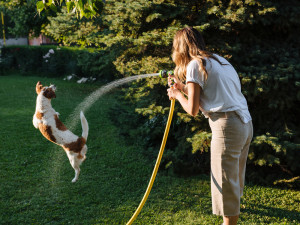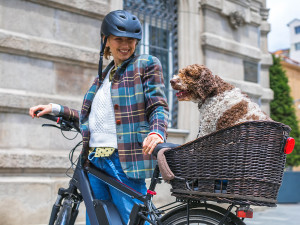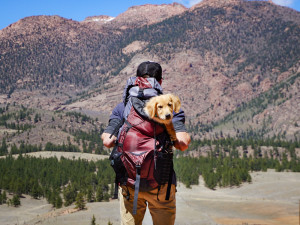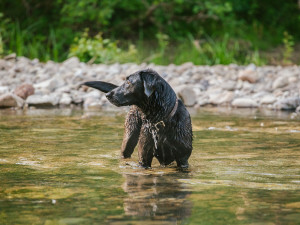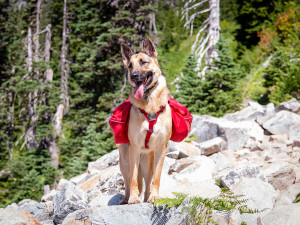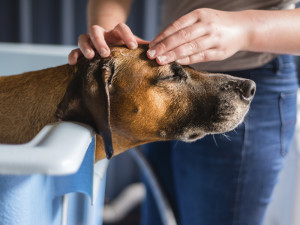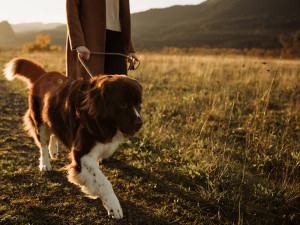How to Safely Make Your Dog Your First Mate
You’re on a boat, but does your dog want to be there, too?

Share Article
You’ve got your friends you vacation with, your friends you have over for watch parties of your favorite trashy TV show, and you have your camping friends. These are the people who know how to tie the trash bag high enough in the tree, who bring extra sunscreen and bug spray, and who know roasting two marshmallows at once is the way to go. These folks are all great choices to keep in your circle, but at the end of the day, your real go-to camping buddy is your dog. But is your pup up for all the camping adventures, such as, say, canoeing?
If you’re thinking about taking your dog along for an overnight canoeing trip, a little planning will ensure a safe and happy journey. Here are a few tips to help you plan your canoeing adventure.

Save on the litter with color-changing tech that helps you better care for your cat.
Will Your Dog Like Canoeing?
First, consider whether your dog will actually enjoy going out on a canoe. The truth is that not all dogs can be chill while in and around the water. Beyond that, will they tolerate the tedium of sitting in a boat, be at ease with the rocking, and sleep soundly in a tent?
Try this: For your maiden voyage, opt for an easy day trip close to home rather than a hardcore back-country expedition. Lazy-water journeys are just right for many dogs. Most dogs will hop into a canoe out of curiosity, especially if treats are involved, but allow yours plenty of time to feel secure. Plan ahead and train your dog to be in a boat.
Five Tips for Taking Your Pup on a Canoe Adventure
1. Give Your Dog Plenty of Time to Stretch
Before launching, take a swim, roam the shoreline, or play a game of fetch. “Don’t forget that your pup has been watching you pack up at home, sat patiently for a long car ride, and is in a new and exciting place,” says Kathryn Howell, owner of Dog Paddling Adventuresopens in new tab, a Canadian travel outfit offering wilderness excursions for people and their dogs. “To [expect] them to sit still like a good pup for an hour in the boat may be too much to ask.”
2. Follow Water Safety and Bring a Lifejacket
Let’s face it: water is never-never land for many dogs. Many Labs would take “just one more” swim all day if you let them. That’s why a lifejacket is essential, even for bona fide water dogs, as they can be affected by fast river currents, water intoxication, cold water, or a disorienting fall out of a capsized canoe. Doggie personal flotation devices (Ruff Wearopens in new tab makes a great one called a K-9 Float Coatopens in new tab) provide security for puppies, seniors, and timid swimmers; they also keep wet dogs warm after a swim or cool by trapping moisture and blocking the sun.
3. Bring All the Right Gear
You’ll need a few things to have a successful trip in addition to a lifejacket. A leash may be helpful if you plan on exploring on land, but never leash your dog to the canoe or any other boat. A few must-haves for your trip include bowls, fresh water, food, a mat, a towel, and a pair of tweezers for tick removal. It’s good practice to pack out what you pack in, which includes dog poop. So, bring plenty of poop bags.
4. Teach Basic Obedience Cues
When you are out on the water or camping with your dog, it’s also helpful for them to follow basic cues like stay, leave it, and, of course, have a spot-on recall. At camp, good canine manners are a must. Your pup should be well-behaved around fellow campers and willing to follow your cues during new situations.
5. Give Your Dog a Place to Settle In
Allow your pup time throughout the day to get their energy out. Trips usually entail wet dogs rolling in sand with tongues lolling and paws pointing skyward, but letting dogs be dogs pays off later. “By the time dusk settles in, they are fast asleep,” Howell says of her canine clientele. If you’ve brought a comfy mat for your dog to sleep on, after dinner you’ll be able to kick back by the fire and listen to owls call out and coyotes yelp in the distance while your dog takes a snooze.
Things Don’t Always Go Perfectly
If canoe-camping with your dog isn’t postcard-perfect on the first try, don’t give up. Skip the campout, perhaps, and take a relaxing, low-key afternoon paddle together. Most dogs would rather do anything than be left behind, and with patience and time, you’ll be rewarded with a seasoned traveling companion.
Andi Marie Cantele
Andi Marie Cantele is the author of Backroad Bicycling in Western Massachusetts and 52 Weekends in Connecticut (both from Countryman Press), among others; she lives in Connecticut.
Related articles
![Man backpacking with his Golden Retriever puppy in a state park]()
51 Dog-Friendly US Spots to Visit With Your Pup This Summer
Where to go and what to do—from Alabama to Wyoming.
![Black Lab playing in creek]()
Why Your Dog Should Stay Far, Far Away From Blue-Green Algae This Summer
Consider getting a water-testing kit to keep your pup safe.
![A German Shepherd dog wearing a red hiking backpack on a rocky trail.]()
11 Must-Have Items to Take on a Hike with Your Pup
When heading out on a hike with your dog, the items you pack will vary from trip to trip and dog to dog, but there are a few things that every hiker should have packed. Here are the top ten hiking essentials for pet parents. Don’t forget these hiking essentials.
![A dog getting its head checked for ticks]()
5 Myths About Ticks That Every Dog Parent Should Know
Found a tick on your dog? A veterinarian breaks down everything you need to know.
![Dog on leash running in a field without foxtails]()
Why Foxtails Are So Dangerous for Your Dog
Late spring is prime time for these blades of grass that pose a serious risk to your pup.
